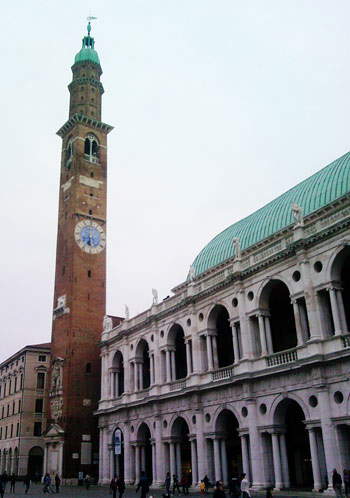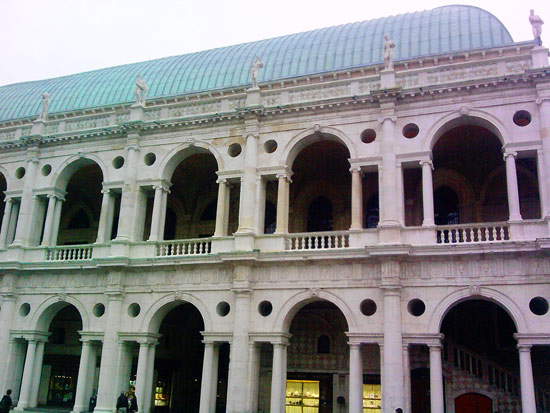Oh happy days of Palladio and enviable joy! For him, the Basilica had become his longed-for poem, and great credit was due to Trissino: much also to that host of nobles, who showed him so much favor; and Vicenza, which was adorned with palaces, saw the rise of a highly praised head of work (Francesco Formenton, Storia e illustrazione della basilica di Palladio in Vicenza, 1870).
Hardly on Finestre Sull’Arte have we dealt with architecture, since our site focuses mainly on painting and sculpture. But it is impossible not to talk about architecture when visiting the wonderful city of Vicenza: a Renaissance treasure chest, still not distorted by massified tourism, and therefore genuine, characterized by the works of Andrea Palladio (1508 - 1580), one of the greatest architects in history. Originally from Padua, he designed buildings reminiscent of those of Greek and Roman antiquity, and it was in Vicenza that he found fertile ground for his art, as he was fully supported by modern and intelligent patrons. There are several Palladian works that beautify Vicenza and its surroundings and make the city one of the most fascinating not only in Italy, but in the whole world: try to visit it to believe :-) However, if we think of the most well-known, the Palladian masterpiece, the one that most characterizes Vicenza, a very specific one comes to mind: the Loggias of the Basilica.
 |
| The Palladian Basilica of Vicenza |
They are also known as Palladian loggias and are the symbol of the city. They clothe the building known as the Basilica, which, despite its name, has nothing to do with religion: it is in fact the ancient Palace of Reason, also called, precisely, “Basilica” according to the use of this term in ancient Rome. It was, that is, the place where business was conducted (the ground floor was home to stores and stores) and where the life of the city was administered, because the upper floor housed a huge single hall, covered by a hull vault (this is the one we see today, which was rebuilt following the bombings of World War II, faithfully to what it once was), where the city council met. Today, however, the Basilica has become a place of culture: it has been musealized and hosts exhibitions and events. Curiously, in the 1960s, the Basilica also served as a sports field: in fact, it was the venue for the Vicenza basketball team’s home games.
In 1546 Palladio began planning the restoration of the ancient building, which is of 15th-century origin (to be exact, it was built between 1449 and 1460, replacing some pre-existing medieval constructions), initially built in Gothic forms. In 1496 the Basilica suffered a collapse that led the city council to discuss a possible renovation: several great architects of the time were involved in the debate, from Giulio Romano to Sebastiano Serlio via Jacopo Sansovino and Michele Sanmicheli. It had to be until 1546, however, to see a project approved by the Vicenza council: and the project was indeed Palladio’s. His idea was to cover the Basilica with loggias made of stone from Piovene di Rocchette (near the Asiago Plateau). Therefore, the architect created two orders of overlapping loggias, which are characterized by the use of modules that are repeated and consist of serlianas, or architectural elements that are composed of a round arch between two rectangular openings bordered by columns. The serliana is named after the aforementioned Sebastiano Serlio since it was he, in his treatise on architecture, who provided the most detailed descriptions of this type of structure, which is somewhat of a “trademark” of Palladio’s works.
Why did the architect, for the Basilica, choose the structure of the Serliana? It is the engineer Francesco Formenton, whom we quoted at the beginning of this article, who offers us a key to understanding: Palladio used supreme shrewdness in the construction of the new arches, so as to achieve solidity, harmony and magnificence. Solidity, because the serlianas effectively support the weight of the vault. Harmony, because Palladio could modify the width of the side openings to create a balanced work: and we see this in the corners, where the side openings of the serlianas are reduced a little to better fit the size of the building (also seen in the photo: we notice that in the last serliana the round openings above the side elements disappear, precisely because the width is reduced). Magnificence, because the serliana is reminiscent of a triumphal arch!
Palladio’s construction is indeed reminiscent of antiquity: as in Greek temples, the entablature (that is, the horizontal element supported by the columns) is covered by a frieze with triglyphs (the panels with three vertical grooves) and metopes (which are the decorated panels instead). The upper loggia, on the other hand, rests on a balustrade, while its architrave has a continuous frieze. The columns are also inspired by antiquity: those of the lower loggia are of Doric order, while those of the upper loggia are of Ionic order.
 |
| The loggias of the Palladian Basilica |
Unfortunately, Andrea Palladio was not in time to see his work completed: he could only see the lower loggia finished. But despite this, he already imagined the greatness of his work. Yes, because in his Quattro libri dell’Architettura, the treatise published in 1570, he spoke thus of his Basilica: another there is in Vicenza, of which only I have placed the drawings, because the porticos, ch’ella hà d’intorno, are of my own invention: and because I do not doubt, that this fabrica cannot be compared à gli edificij antichi, et annoverata tra le maggiori, e le più belle fabriche, che siano state fatte da gli antichi in quà, sì per la grandezza, e per gli ornamenti suoi: come anco per la materia, che è tutto di pietra viva durissima, e sono state tutte le pietre commesse, e legate insieme con somma diligenza. The second level was finished in 1597, seventeen years after Palladio’s demise, while the work on the Piazza delle Erbe side ended in 1614. The work then underwent a number of structural and functional rearrangements over the centuries: one of the most important occurred recently, between 2007 and 2012: 2012 was also the year of the reopening of the Basilica, which since then, as mentioned, has been hosting exhibitions, displays, and events.
The work is so representative of the genius of the architect who designed it that it is now known as the Palladian Basilica. And the Basilica, for more than four centuries, has surprised visitors to Vicenza with its classical splendor, with its composed majesty. To see it appear before one’s eyes, hidden among the city’s Renaissance palaces, is an emotion that catches you by surprise: it means taking a journey into beauty, it means imagining that you are immersed in the intellectual fervor of those years, when classical proportions, ideal beauty, and reminders of antiquity were discussed. The great German writer Johan Wolfgang Goethe, standing in front of the Basilica Palladiana, said he could not find the words to express the effect it had on him. But, at the same time, he was convinced that in front of these great monuments one could really recognize their great value. We have tried to describe our impressions, but it is really hard to blame Goethe.... !
Warning: the translation into English of the original Italian article was created using automatic tools. We undertake to review all articles, but we do not guarantee the total absence of inaccuracies in the translation due to the program. You can find the original by clicking on the ITA button. If you find any mistake,please contact us.